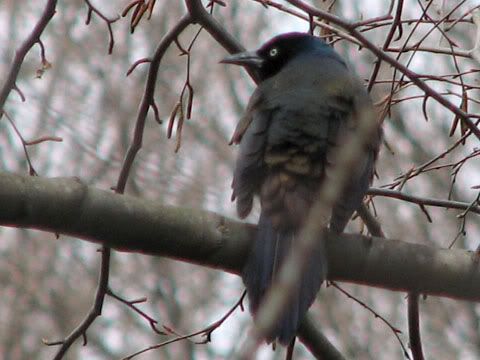365 Urban Species. #080: Common Grackle

Urban Species #080: Common grackle Quiscalus quiscula
To many people, a grackle is a mundane sight: a common blackbird feeding in a field or a suburban lawn. But in Boston, in March, we need all the harbingers of spring we can find, and the grackles' return should be as welcome as any. Their black feathers, caught in the sunlight, contain some of the loveliest irridescence of any of our common birds. And their grating call, like that of the European starling, is surprisingly complex. They return in early spring in huge numbers, all glossy purple and bronze, sounding like a hundred rusty hinges creaking and clattering (My partner, cottonmanifesto has described the sound of a flock of grackles as a "continuous car accident.")
Human use of the land over the past few centuries has been beneficial to the grackle. The clearing of the dense forests of the east helped their spread, and the farmland that replaced the forests provided new sources of food: not only the crops, but especially the rodents and insect pests of the crops. To the west, the ornamental shrubs and trees that now pepper the suburbs have allowed grackles to spread in that direction. In the south and southwest the common grackle is joined by much larger relatives. Along the coast of the southeast, and the Gulf of Mexico, there is the boat-tailed grackle Quiscalus major; throughout the southwest and expanding northeast, is the great-tailed grackle Quiscalus mexicanus. These two species are very similar--in fact they are sometimes considered the same species--and look a lot like common grackles but are much larger, with a much larger tail. Also the male and female look more different from one another than in the common grackle, females of the large species are brown and smaller than the males. All three grackle species are urban--in parts of Las Vegas for example, a challenging city for an urban naturalist, the great-tailed grackle is the most conspicuous urban bird.